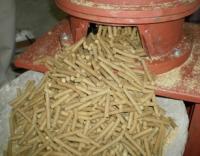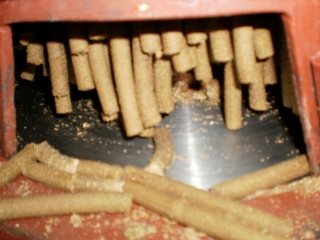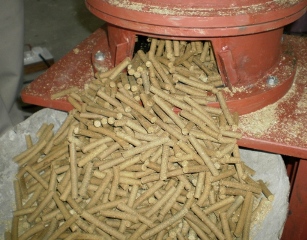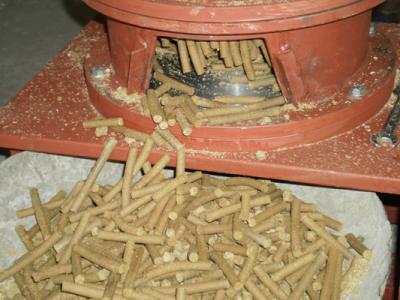Submitted by WOTR RE on
Currently the fuel pellets are manufactured in a centralized location and then transported to areas where there is a requirement. This system that is adopted today has its flaws, some of which are mentioned below.
- The centralized production of the pellets does not allow for rapid expansion of the stove market since beyond a certain area the transportation cost of the pellets becomes unviable. Hence the supply of pellets for a specific area has to be ensured before entering the market.
- Centralized production also increases the cost of production (due to increased overheads, transportation etc.) and packaging.
- The continuous supply of pellets to customers can falter if the plant for any reason stops supplying the same.
- It doesn’t valorize local wastes and doesn’t offer an occasion to generate local livelihoods
- There is a net transfer of resources from the village to urban/ industrial centers thus continuing with the existing iniquitous and detrimental terms of trade between the 2 entities and perpetuating poverty.
In order to overcome the problems of centralized production, decentralized pellet production was our obvious solution. The machine envisaged will produce pellets for a certain locus of customers and will be affordable enough for local entrepreneurs to take it up as a business venture. This will not only reduce the cost of pellets drastically but also has the potential to ignite a local industry. Its available in 1 HP and 3 HP models.(see figure in Gallery)
Specifications for 1 HP Model:
- Volts: 220 – 240 AC
- Frequency: 50 Hz
- Ampere: 7
- Ambiance: 40 degree
- RPM: 1440
- Phase: Single
- KW: 0.75
- Output production / hr: 10 to 14 kg / hr
Specifications for 3 HP Model:
- Volt s - 220 – 240 AC
- Frequency: 50 Hz
- Ampere: 15
- Ambiance: 40 degree
- RPM: 1440
- Phase: Single
- KW: 2.25
- Output production / hr: 16 to 20 kg / hr
Raw materials used (dry and pulverized – moisture contents 11 to 15%):
- Ground nut shell
- Soya dust
- Wood dust
- Bagases
- Grass
- Rise husk
- Coconut (coir)
Conclusions:
- The cooking energy need in low income households can be met in a clean and renewable way through the use of the Agni Biomass stove
- The Stove is perfectly suitable to a typical rural household as has been proven by our field tests
- There are certain technical difficulties (battery discharge, pellet supply etc.) that are hindering the pace at which we would like to implement this project
- These problems can be overcome through the development “natural updraft stove” model and the “decentralized pelletizer”. This would greatly increase the overall economic viability of the “Biomass stove” project.
- Log in to post comments





Comments
boypoet replied on Permalink
FABRICATING AND DECENTRALIZING PELLETIZERS
Hi,
I found these materials very interesting very timely with current issues on my mind vis a vis biomass and fuels for cooking stoves.
I reckon that the issue of fabricating and decentralizing biomass pelletizers boils down to the same facts, sustainable use of resources. In an economy where the cost effectiveness of biomass fuels is yet to be appreciated( with its other advantages as in carbon emissions reduction); Centralized but strategic production would be saavy. In this case, the demographics of cooking stoves compatible with the biomass pellets would be an important factor.
So the idea is send cooking stoves compatible with biomass pellets into the identified markets first, manage information on this supply and next produce the pellets for fueling. I hope with time, the system would be decentralized, so much that technical expertise would only be retained for maintenance, regulation and upgrades of the devolved units of biomass pellets compatible cooking stoves.
I am involved in a current project to produce biomass pellets as fuel options, now as a researcher with the Transition network: www.transitionnetwork.org in the process of forming steering committees for energy descent communities and solutions(transition communities) in Nigeria and West Africa in conjunction with such other movements/interests in Brazil.
References to work I have been involved with on pellets can be found on http://stoves.bioenergylists.org/technology-development-Nigeria
Thanks,
Akin Olatidoye,
Nigeria.
Skype ID: akin.olatidoye
Professional profile: www.linkedin.com/in/akinolatidoye
cacique replied on Permalink
biomass pellitizer
I have been thinking about shipping wood pellets from Florida to Haiti. Cooking with pellets would permit planting trees in Haiti and maybe get some carbon credits. Will this work? Comments, and input welcomed. Thanks
Erin Rasmussen replied on Permalink
Shipping pellets to Haiti
the shipping companies will happily erase your profit margin.
Otherwise, it may be feasible.